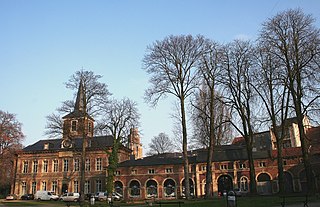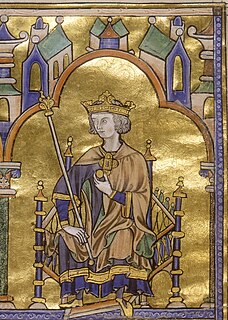
Isabelle of France was the daughter of Louis VIII of France and Blanche of Castile. She was a younger sister of King Louis IX of France and of Alfonso, Count of Poitiers, and an older sister of King Charles I of Sicily. In 1256, she founded the Poor Clare monastery of Longchamp in the part of the Forest of Rouvray, west of Paris. Isabelle consecrated her virginity and her entire life to God alone. She is honored as a saint by the Franciscan Order. Her feastday is the 26th of February.
Faremoutiers Abbey was an important Merovingian Benedictine nunnery in the present Seine-et-Marne department of France. It formed an important link between the Merovingian Frankish Empire and the southern Anglo-Saxon kingdoms of Kent and East Anglia.

Chelles Abbey was a Frankish monastery founded c. 658 during the early medieval period. It was intended initially as a monastery for women; then its reputation for great learning grew, and with the afflux of men wishing to follow the monastic life, a parallel male community was established, creating a double monastery.

The maîtresse-en-titre was the chief mistress of the king of France. It was a semi-official position which came with its own apartments. The title came into use during the reign of Henry IV and continued until the reign of Louis XV.
When the Viking chieftain Rollo obtained via the Treaty of Saint-Clair-sur-Epte the territories which would later make up Normandy, he distributed them as estates among his main supporters. Among these lands were the seigneurie of Harcourt, near Brionne, and the county of Pont-Audemer, both of which Rollo granted to Bernard the Dane, ancestor of the lords (seigneurs) of Harcourt. The first to use Harcourt as a name, however, was Anquetil d'Harcourt at the start of the 11th century.
John VI of Harcourt was a count of Harcourt. He was son of John V of Harcourt and Blanche of Ponthieu who was the sister of Jeanne of Ponthieu.
Marguerite de Sablé, Dame de Sablé, was a French noblewoman and one of the wealthiest heiresses in the counties of Anjou and Maine. She was the eldest daughter of Robert de Sablé, and the wife of William des Roches, Seneschal of Anjou, who two years after his marriage to Marguerite became one of the greatest barons in Anjou and Maine, her considerable inheritance having passed to him upon her father's death in 1193.
Isabelle de Meulan, Dame de Mayenne, Dame de Craon was a French noblewoman, being the daughter of Waleran de Beaumont, 1st Earl of Worcester, Count of Meulan. Isabelle married twice; firstly to Geoffroy, Seigneur de Mayenne, and secondly to Maurice II, Sire de Craon. Her eldest son Juhel III de Mayenne was a celebrated Crusader.

Godfrey of Brabant, was the first Lord of Aarschot, between 1284 and his death in 1302, and Lord of Vierzon, between 1277 and 1302.

Forest Abbey was a Benedictine Abbey founded in 1105, beside a creek, a tributary of the Zenne, southwest of the city of Brussels, Belgium in the municipality of Forest.

Women letter writers in early modern Europe created lengthy correspondences, where they expressed their intellect and their creativity; in the process, they also left a rich historic legacy.
Agnes d'Harcourt was an author and the abbess of the Abbey of Longchamp.

Amaury III de Craon, Lord of Créon, Mareuil and Sablé, Seneschal of Gascony as well as seneschal of Anjou, Maine and Touraine.

Pentemont Abbey is a set of 18th and 19th century buildings at the corner of Rue de Grenelle and Rue de Bellechasse in the 7th arrondissement of Paris. The abbey was a Cistercian convent founded near Beauvais in 1217 and moved to its current site in Paris in 1672 at the behest of Louis XIV. A reconstruction of the abbey was initiated in 1745 by the Abbess Marie-Catherine Béthisy de Mézières and work was completed in 1783. In the late 18th century the abbey was one of the most prestigious educational institutions in Paris for daughters of the elite, including two of Thomas Jefferson's. The abbey also provided rooms for ladies of good standing who were in search of rest, including Joséphine de Beauharnais when the case of her separation from her first husband was heard.

The Abbey of Notre Dame aux Nonnains, also called the Royal Abbey of Our Lady of Troyes, was a convent founded before the 7th century in Troyes, France. The non-cloistered canonesses became wealthy and powerful in the Middle Ages. In 1266–68 they defied the pope and used force to delay construction of the collegiate Church of St Urbain. They were excommunicated as a result. Later the abbey adopted a strictly cloistered rule and the nuns became impoverished. Work started on building a new convent in 1778 but was only partially completed before the French Revolution (1789–99). The abbey was closed in 1792 and the church was demolished. The convent became the seat of the prefecture of Aube.
The Abbaye Notre-Dame de la Déserte or Abbaye de la Déserte, was an abbey in Lyon, France. Founded in 1303 by Louis de Villars, Bishop of Lyon it housed the Poor Clares from 1304 till 1503, then Benedictine nuns from 1503 to the French Revolution, when it was dissolved. It was demolished in 1814.

The abbey of Saint-Ausone is a Benedictine abbey founded in Angouleme in the Charente in the 11th century.

Henri IV de Sully, Grand Butler of France, Treasurer of France, Lord of Sully was a 13th-14th century French noble.























